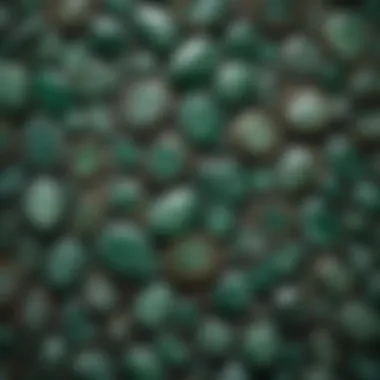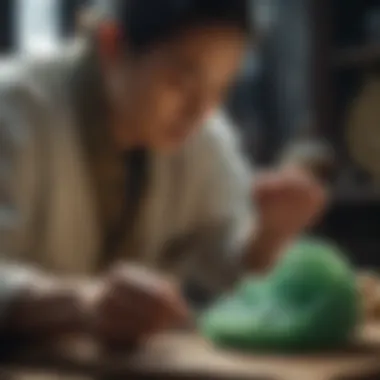The Allure of Authentic Jade Jewelry Explained


Intro
Jade jewelry holds a captivating position in the world of gemstones. For centuries, it has represented more than just beauty; it symbolises culture, history, and connection to heritage. Understanding jade goes beyond its mere aesthetic appeal. This section sets the stage to explore the wider context of gemstones and minerals before zeroing in on the unique allure of jade.
Overview of Gemstones and Minerals
Gemstones and minerals have fascinated humans throughout history. From the earliest days of civilization, people valued these natural wonders for their beauty and their believed magical properties. Each gemstone tells a story, rooted deeply in the earth's processes and the beliefs of various cultures.
History of Gemstone and Mineral Use
The use of gemstones can be traced back thousands of years. Ancient Egyptians utilized lapis lazuli and turquoise in their jewelry, while the Chinese revered jade, regarding it as a symbol of virtue and beauty. Historical records show that cultures around the globe have crafted items from gemstones, turning them into talismans, decorative pieces, and status symbols.
Significance in Culture and Society
Each culture assigns its own significance to various gemstones. Jade, in particular, has maintained a unique status in many societies. In Chinese culture, jade is seen as a protector and a source of wisdom. Its association with wealth and status persists today. Meanwhile, in Mesoamerican cultures, jade was believed to embody life and fertility.
Overall, the allure of genuine jade jewelry lies in its rich historical and cultural significance, which deserves further exploration as we dive into its properties and uniqueness.
Gemstone Formation and Properties
Understanding how gemstones like jade are formed can shed light on their value and attributes.
Formation Process of Gemstones
Jade forms under specific geological conditions. It results from the metamorphosis of certain types of rock under extreme pressure and heat. The two primary types of jade are nephrite and jadeite. Nephrite typically comes from metamorphic conditions, while jadeite is formed in igneous environments.
Properties that Define Gemstones
Gemstones are distinguished by various properties, including their hardness, luster, and refractive index. Jade is notable for its toughness, being harder than many other gemstones, which enhances its desirability in jewelry making.
Classification based on Color, Hardness, and Luster
Jade comes primarily in shades of green but also displays white, lavender, yellow, and even red hues. The color results from microscopic inclusions and the specific minerals present. Understanding these classifications can assist collectors in identifying and appreciating the nuances in authentic jade pieces.
Types of Gemstones
There is a vast array of gemstones, each with its own unique qualities.
Precious vs. Semi-Precious Gemstones
Traditionally, gemstones are categorized into precious and semi-precious. Precious gemstones include diamonds, emeralds, sapphires, and rubies, while semi-precious ones may include jade, amethyst, and garnet. However, the distinction is becoming less significant as appreciation can vary greatly.
Common Gemstone Varieties
Some of the widely recognized gemstones include:
- Amethyst
- Citrine
- Garnet
- Topaz
Exotic and Rare Gemstones
Beyond common varieties, there exist rare gemstones that capture the hearts of enthusiasts. Examples include:
- Taaffeite
- Painite
- Red Beryl
Each of these stones offers its own set of characteristics and charms, inviting exploration.
Identifying and Evaluating Gemstones
Understanding how to identify and evaluate gemstones is crucial for collectors.
Factors Affecting Gemstone Value
Several factors influence the value of gemstones, such as:
- Clarity
- Color
- Cut
- Carat weight
Techniques for Gemstone Identification
To identify genuine jade, one must consider techniques like:


- The "scratch test" to assess hardness.
- The visual inspection for inclusions and color consistency.
- Professional gemological testing for certification.
Assessing Gemstone Quality
When evaluating jade's quality, clarity and color intensity play significant roles. A deeper green color often indicates higher quality, but other shades can also possess unique beauty.
Caring for Gemstones
Proper care of gemstones extends their beauty and longevity.
Cleaning and Storing Gemstones Properly
To maintain jade's allure, it is best to clean it with soft cloth rather than harsh chemicals. Keeping gemstones in individual pouches can prevent scratching.
Avoiding Common Mistakes in Gemstone Care
Avoid exposing jade to extreme temperatures or chemicals, as these can alter its appearance. Being mindful of these factors is essential for preserving its natural beauty.
Preservation Tips for Specific Gem Types
Different gemstones require tailored care. For jade, regular inspections will help catch any scratches or damage early on, allowing for timely intervention.
Understanding Jade
Understanding jade is essential in appreciating its beauty, value, and significance across cultures. This section aims to provide a foundation for discussing jade jewelry. Starting from the definitions to the different types of jade, readers will gain insight into why jade holds such an esteemed position in both historical and contemporary contexts.
Defining Jade
Jade comprises two distinct minerals: nephrite and jadeite. Each type possesses unique characteristics and varies in value. Nephrite is known for its softer texture and extensive historical use, while jadeite is rarer and often more expensive due to its vivid colors. Understanding the definitions allows jewelry enthusiasts and collectors to better appreciate their purchases. Authentic jade is mined primarily in regions like China and Myanmar, which contribute to its allure.
Types of Jade
Nephrite
Nephrite, a type of jade, is predominantly found in shades of green, gray, and black. It is characterized by its toughness and resistance to breaking, making it ideal for intricate carvings. This durability is one of the reasons nephrite is popular for jewelry. Its accessibility in many regions adds to its appeal.
Some advantages of nephrite include:
- Affordable price compared to jadeite
- Extensive history and cultural significance in Chinese culture
However, its more muted color can be less desirable for some collectors seeking vibrant pieces.
Jadeite
Jadeite stands out with its varied colors, ranging from emerald green to lavender and even translucent white. Its beauty lies in its intense color and rarity, often making it a more sought-after choice for those interested in high-quality jade jewelry. Jadeite's hardness also allows for polished finishes, enhancing its visual appeal.
Key characteristics of jadeite include:
- Rarity, which often drives its price up
- Ability to be fashioned into more elaborate designs
Yet, the higher price point can limit accessibility for some, contrasting with nephrite.
Cultural Significance
Chinese Traditions
In Chinese culture, jade represents purity and moral integrity. It has been used for thousands of years in various forms, including jewelry, ornaments, and even burial items. The significance of jade extends into beliefs, where it is thought to protect and bring good luck.
Often, jade pieces are intricately carved with symbols conveying blessings. This deep-rooted connection to cultural traditions makes understanding jade crucial for collectors who wish to appreciate its historical context and value.
Mesoamerican Cultures
Similarly, jade held great significance among Mesoamerican cultures, like the Maya and Aztec. They viewed jade as a precious stone tied to life and death. It was often used in religious ceremonies and as offerings to deities.
The unique craftsmanship of Mesoamerican jade artifacts highlights the importance of jade in their cultures and provides insight into ancient beliefs and customs.
In summary, understanding jade—its types and cultural significance—sets the stage for deeper appreciation of its qualities and allure. It is through this lens that collectors and enthusiasts can truly value authentic jade jewelry.
The Journey of Jade: From Mine to Market
Understanding the journey of jade, from its natural origins in the earth to its final presentation as intricate jewelry, is essential to appreciate its value and significance. This section covers the complexities involved in sourcing and crafting jade, shedding light on the processes that ensure the authenticity of jade jewelry. Recognizing these elements not only benefits consumers in their purchasing decisions but also elevates their appreciation for this remarkable gemstone.


Sourcing Authentic Jade
Geographic Sources
Geographic sources play a crucial role in determining the quality and character of jade. For authentic jade, regions like Myanmar, Guatemala, and the Xinjiang province in China are particularly noteworthy. Each location produces jade with unique qualities, which influence both its appeal and market value.
Myanmar, particularly famous for jadeite, produces stones with vibrant colors, particularly green. This rich coloring and translucence make it highly desirable among collectors. On the other hand, Nephrite, primarily sourced from regions like New Zealand and British Columbia, is known for its toughness and more muted color variations.
The significance of the geographic source cannot be overstated. For instance, jade from Myanmar is associated with the highest value in the market, often fetch higher prices compared to Nephrite. However, sourcing jade can present challenges such as ethical considerations and environmental impact. The practices in jade mining can vary significantly, and buyers must be vigilant to ensure they are purchasing responsibly sourced material.
Mining Processes
The mining processes associated with jade vary depending on the source. For instance, the extraction methods can range from traditional hand-mining to modern mechanized operations. Each method carries its implications, particularly regarding environmental impact and worker safety.
Traditional mining practices, often found in regions like New Zealand, focus on small-scale operations that respect the land. This method tends to preserve the geological conditions of the areas, allowing for sustainable harvesting of jade. On the other hand, mechanized mining, which is common in Myanmar, can lead to more efficient extraction but often results in significant environmental degradation.
It's crucial to be aware of these mining processes as they directly affect the quality of the jade. Ethical concerns can arise from irresponsible mining practices, which may lead to a negative perception of jade as a commodity. As the market evolves, there is growing pressure for ethical sourcing, and understanding these processes positions consumers to make informed decisions.
Crafting Jade Jewelry
Carving Techniques
The art of jade carving is a hallmark of authentic jewelry making. Skilled artisans employ various carving techniques to create intricate designs that enhance the natural beauty of the stone. Techniques often include simple shaping to complex relief work, showcasing not only the stone's character but also the artisan's skill.
One prominent characteristic of jade carving is the preference for working with the stone's natural contours. This approach ensures that the inherent qualities of jade, such as its translucence and unique patterns, are highlighted. As a result, the jewelry becomes not just a piece of adornment but a work of art.
While traditional techniques remain popular, modern advances in tools have expanded the possibilities. However, over-reliance on technology can sometimes compromise the craftsmanship traditionally associated with jade. Thus, a balance between innovative techniques and time-honored practices is essential for producing authentic jade jewelry.
Finishing Processes
Finishing processes are equally important in the crafting of jade jewelry. After carving, pieces undergo polishing to enhance their luster. Different methods, such as tumbling or hand polishing, may be used. Each method brings its unique attributes to the final product.
The key characteristic of finishing techniques is their role in elevating the overall aesthetic appeal of jade jewelry. A well-finished piece presents a smooth surface, allowing light to interact with the jade, further enhancing its natural beauty. However, it is essential to recognize that over-polishing can diminish the stone's natural characteristics.
Additionally, meticulous attention in the finishing stages can make or break the quality of jade jewelry. The right finishing techniques ensure durability while preserving the authentic feel of the gemstone. Ultimately, understanding these processes enriches one's appreciation of jade jewelry, as it is a reflection of art and skill.
Identifying Authentic Jade Jewelry
Identifying authentic jade jewelry is crucial for collectors and enthusiasts alike. The market is flooded with imitations and synthetics, making it essential to distinguish genuine items from faux ones. Not only does knowing how to identify authentic jade enhance your collection, it also preserves the cultural and monetary value of each piece.
Visual Characteristics
Visual characteristics are among the first indicators of genuine jade. Understanding color variations and transparency levels can greatly assist anyone in evaluating a piece.
Color Variations
Color variations in jade may range from deep greens to pale whites and lavenders. Each color holds significance and influences desirability. For example, the rich, emerald-green jadeite is often most sought after, symbolizing prosperity and balance in various cultures.
A key characteristic of color variations is hue saturation. A vibrant color usually indicates greater quality and value, which benefits collectors aiming to make informed purchases. However, beauty is subjective; some may prefer softer, pastel shades for their subtle elegance.
A unique feature of jade’s color variations is its potential for blends. These blends can create stunning visual effects, making a single piece of jade truly one of a kind.
Transparency Levels
Transparency levels can also indicate authenticity. Genuine jadeite may display a translucent quality, allowing light to filter through, while nephrite tends to be more opaque.
The degree of transparency is a vital characteristic in identifying high-quality jade. Pieces that exhibit some levels of transparency are generally considered more valuable.
However, the unique feature of transparency levels is that they can vary widely even within the same stone. This variability can make jade more challenging to authenticate for the untrained eye.
Testing Authenticity
Testing authenticity provides an extra layer of confidence in purchasing jade jewelry. The two tests often utilized are the scratch test and the light test.
Scratch Test
The scratch test examines how the jade reacts to abrasion. Genuine jade is known for its durability, so it will resist scratching by materials like glass.
This is a beneficial choice because that allows anyone to verify authenticity without needing specialized tools. However, this method has drawbacks; if done incorrectly, it can damage the surface of the jade, affecting its resale value.


Light Test
The light test assesses the jade’s light permeability. By holding a piece against a light source, you can determine whether it is genuine. Quality jade will often have a somewhat cloudy appearance when backlit, which is an indicator of jadeite.
This method is popular among collectors because it requires no special tools. Nonetheless, determining authenticity can still be challenging without extensive experience, as lighting conditions can affect the outcome.
Learning to identify authentic jade jewelry not only protects investments but also deepens appreciation for this exceptional stone.
The Market for Authentic Jade Jewelry
The market for authentic jade jewelry has garnered increased attention recently, both for its intrinsic beauty and investment value. This segment of the jewelry market reflects not only aesthetic appeal but cultural resonance. Jade jewelry connects deeply to traditions, representing more than just ornamentation. It serves as a marker of status and an embodiment of history, making it an essential aspect of this discourse. Understanding the dynamics of this market can provide rich insights for enthusiasts and investors alike.
Current Trends
As globalization continues reshaping markets, several trends emerge regarding jade jewelry. Consumers increasingly seek authenticity in their purchases, which has elevated the demand for certified jade pieces. This shift toward verification has led to a rise in interest from gemologists and certified organizations, enhancing the credibility of sellers in this space.
Furthermore, sustainable sourcing is becoming pivotal. Consumers show preference for brands that prioritize then ethical mining practices. They seek suppliers that adhere to sustainability standards and minimize environmental impacts during jade extraction. This eco-conscious consumer base influences production methods and creates a demand for transparency in the supply chain.
Another notable trend is the rise of vintage and antique jade pieces. Collectors are attracted to the stories embedded within these unique items. Those who appreciate craftsmanship and historical significance actively search for well-preserved pieces. This trend highlights a broader appreciation for quality over quantity, fostering a sense of connection to the artisans of the past.
Investment Potential
Investing in authentic jade jewelry presents a multifaceted opportunity. With the increasing global curiosity surrounding jade, its market value has shown a steady incline over recent years. Unlike more volatile stocks, jade often holds its value well, making it an attractive alternative investment.
Several factors influence the investment potential of jade jewelry:
- Quality and Authenticity: Genuine jadeite is highly sought after. Its color, translucence, and craftsmanship significantly affect its market value.
- Cultural Heritage: Jade's cultural significance enhances its desirability, often leading to higher price points in markets rooted in tradition.
- Market Demand: Interest in jade among emerging markets, particularly in Asia, has kept demand robust. Collectors and new consumers are keenly aware of jade's historical importance, which sustains interest.
Investing in jade is not merely a financial decision; it is about appreciating an enduring symbol of culture and history.
Caring for Authentic Jade Jewelry
Caring for authentic jade jewelry is an essential aspect of maintaining its beauty and value. Given the cultural significance and the inherent qualities of jade, proper care can enhance the lifespan and aesthetic appeal of these cherished pieces. Many gemstone enthusiasts and collectors appreciate jade not merely for its appearance but for the stories and heritage it embodies. Therefore, understanding how to care for jade jewelry becomes vital.
Incorporating regular maintenance routines can significantly prevent damage and discoloration. Jade is relatively durable, but it is not immune to scratches or chemical reactions with harsh substances. Hence, both cleaning and storage methods should be considered meticulously to ensure the longevity of jade pieces.
Cleaning Techniques
To maintain the brilliance of authentic jade jewelry, cleaning is necessary. The correct techniques can make a significant difference. Here are a few recommended methods:
- Gentle Soap Solution: Mix a few drops of mild soap with warm water. Soak a soft cloth in this solution and gently wipe the jade. This will remove accumulated dirt without scratching.
- Soft Brush: For intricate designs or settings, a soft-bristled brush can assist in reaching crevices. Apply the soap solution and carefully brush the surface.
- Rinse and Pat Dry: After cleaning, rinse the jade under lukewarm water to remove any soap residue. Pat it dry with a soft cloth rather than rubbing.
It's also crucial to avoid using alcohol, ammonia, or other strong cleaners, as they may deplete the stone of its natural oils and lead to unwanted damage.
Storage Recommendations
Proper storage plays a key role in preserving the quality of jade jewelry. When not worn, jade should be kept in environments that minimize exposure to light, humidity, and physical stress. Here are some practical tips for storage:
- Soft Cases or Pouches: Use soft cloth bags to store each jade piece separately, preventing friction with other jewelry, which can cause scratches.
- Avoid Direct Sunlight: Store jade in a cool, dark place. Prolonged exposure to sunlight can alter its color over time.
- Temperature Control: Jade performs well in stable temperature conditions. Avoid areas subject to fluctuations, such as near heaters or air conditioners.
- Check Regularly: Periodically inspect stored jade to ensure no damage occurs and to keep it looking its best.
"Jade is a resilient stone, but it is not impervious to wear. Careful cleaning and thoughtful storage can extend the life of your beautiful jade jewelry."
In summary, caring for authentic jade jewelry involves thoughtful cleaning and diligent storage practices. By adopting these techniques, collectors and enthusiasts can preserve the inherent beauty and cultural significance of jade for generations to come.
The Future of Jade Jewelry
The future of jade jewelry is a subject of great importance as consumers and jewelers alike become increasingly conscious about the extremes of natural resources and the significance of cultural heritage in jewelry making. Authentic jade jewelry has held a prestigious place in art and adornment for centuries, and as we move forward, several pivotal elements come into play, such as sustainability and innovative designs.
The ongoing environmental concerns regarding mining practices urge both consumers and producers to reassess how jade is sourced. The blend of tradition and modernity presents unique opportunities within the market. It is essential for collectors and enthusiasts to stay informed, as these trends not only shape the value but also influence the allure of jade jewelry in contemporary settings.
Sustainability Issues
As awareness grows surrounding environmental impacts, sustainability becomes a critical focus for the jade jewelry industry. Mining jade often involves significant ecological alterations, including deforestation and habitat destruction. Thus, there is a pressing need to adopt more responsible mining practices.
Many consumers now prefer jewelry from sources that prioritize environmental stewardship. This means that companies must improve transparency in their supply chains, ensuring that the jade they source adheres to ethical and sustainable practices. Some strategies include:
- Supporting local mining communities while minimizing their ecological footprint.
- Implementing responsible extraction processes that protect the landscape and surrounding ecosystems.
- Collaborating with organizations focused on conservation efforts to restore affected areas.
"Sustainability is not only a trend but an essential factor that jewelry buyers value today."
Maintaining balance between economic growth and environmental responsibility will significantly impact the future of jade jewelry. As sustainable practices evolve, jewelry made from responsibly sourced jade is likely to gain higher appreciation, thus enhancing its market value.
Innovations in Jewelry Design
Innovations in jewelry design play a pivotal role in the allure of jade jewelry moving forward. As technology advances, designers are exploring new techniques that blend traditional craftsmanship with modern aesthetics. This fusion opens avenues for creativity, allowing for unique expressions of jade's beauty. Key areas of innovation include:
- New Design Techniques: Embracing modern tools such as 3D printing enables designers to create intricate patterns and shapes that were previously unattainable.
- Hybrid Materials: Combining jade with other metals or gemstones can enhance its visual appeal. Designs utilizing mixed materials attract a broader audience and create distinctive pieces.
- Personalization Trends: As collectors value individuality, bespoke jewelry designs that reflect personal stories or preferences are becoming more popular.







